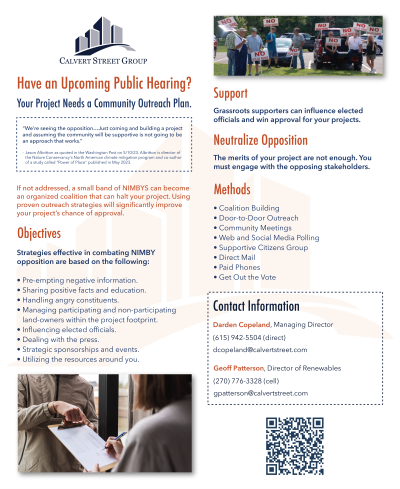Back

Managing Growth
Have an Upcoming Public Hearing? Your Project Needs a Community Outreach Plan
Tuesday, September 12, 2023
4:30 PM - 5:30 PM PDT
Location: Poster Area, Booth #11024, Level 1, Venetian Expo Hall


Darden Copeland
Managing Director
Calvert Street Group
Nashville, Tennessee, United States
Poster Presenter(s)
Developers of utility-scale renewable projects often find themselves caught off guard when they realize that grassroots opposition can derail their projects' progress. They believe things are going well until arriving at a community meeting or planning commission hearing to be greeted by a sea of t-shirts and signs in opposition.
NIMBYism is a challenge the renewables industry must take seriously and address early. Using tactics common among political field campaigns, developers can identify supporters and build a coalition designed to demonstrate community support for their projects.
The key is to start early.
Finding individual supporters takes time, technology, and people power. Supporters must be identified and trained to reach out to others in their networks. They must be persuaded to take action. But how do you determine if someone is merely supporting renewable energy as a good idea or willing to champion your project? How do you convince them to write a letter to the local newspaper or give them the confidence to comment at a public hearing?
Having face-to-face conversations and patiently answering questions is key. No amount of voicemail can replace the effectiveness of “boots on the ground.”
You can be certain that opponents are reaching out for additional resources to stop your project. With social media, opposition groups across the country are communicating with each other. Sometimes, campaign funders in the fossil fuel industry are willing to assist.
In this poster presentation, veteran strategists Geoff Patterson and Darden Copeland will explain how they have successfully managed to build support for renewable energy across the U.S. They will share winning tactics from multiple projects as well as how some of the nation’s top renewable developers have won over local communities even in such a divided political climate.
NIMBYism is a challenge the renewables industry must take seriously and address early. Using tactics common among political field campaigns, developers can identify supporters and build a coalition designed to demonstrate community support for their projects.
The key is to start early.
Finding individual supporters takes time, technology, and people power. Supporters must be identified and trained to reach out to others in their networks. They must be persuaded to take action. But how do you determine if someone is merely supporting renewable energy as a good idea or willing to champion your project? How do you convince them to write a letter to the local newspaper or give them the confidence to comment at a public hearing?
Having face-to-face conversations and patiently answering questions is key. No amount of voicemail can replace the effectiveness of “boots on the ground.”
You can be certain that opponents are reaching out for additional resources to stop your project. With social media, opposition groups across the country are communicating with each other. Sometimes, campaign funders in the fossil fuel industry are willing to assist.
In this poster presentation, veteran strategists Geoff Patterson and Darden Copeland will explain how they have successfully managed to build support for renewable energy across the U.S. They will share winning tactics from multiple projects as well as how some of the nation’s top renewable developers have won over local communities even in such a divided political climate.
